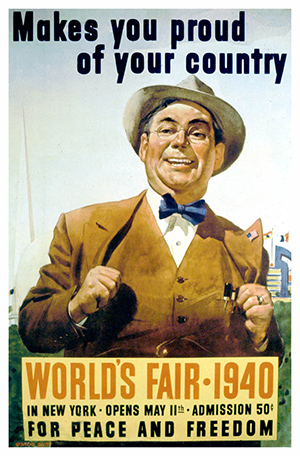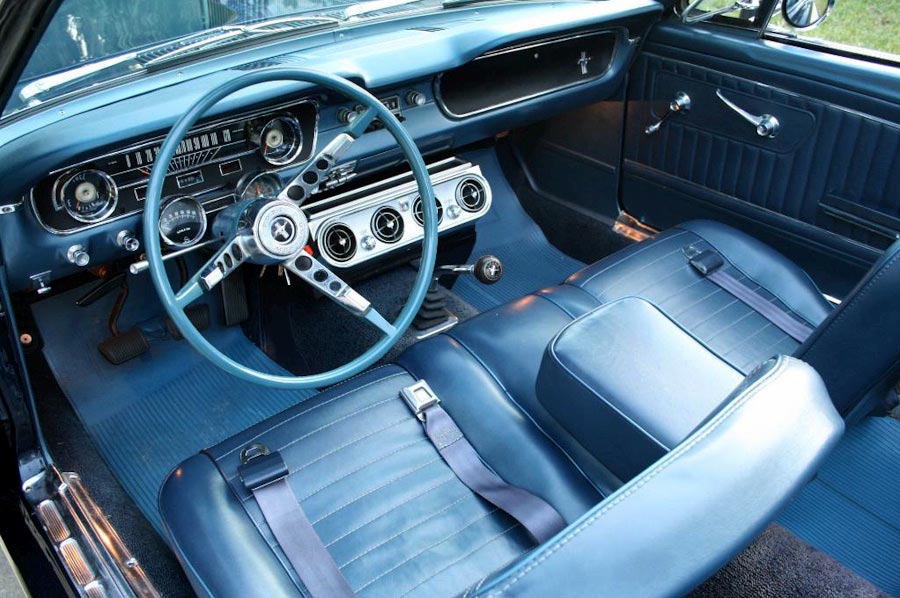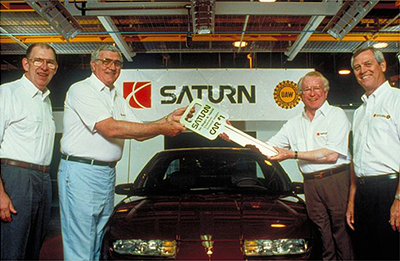75 Years Ago (March 1940): Q1 Output Strong; 2-Tone Specials;
Skilled Trades Shortages; More Rubber Substitutes;
Ward’s Automotive Reports forecasts January-March output at 1,317,000 units, second-highest for the period behind the record 1,546,319 vehicles built in like-1929 and 1.1% ahead of the 1,302,108 turned out in first-quarter 1937. However, any labor disputes halting production for a significant period would undermine the robust outlook.

DeSoto is spiffing up its ’40-model lineup with the spring intro of the Sportsman featuring unique 2-tone color combinations. It is based on the brand’s 4-door Touring Sedan and comes with model-specific nameplates and trim items. The two-tone paint scheme also will appear, in a different format, on midyear limited-edition Dodge sedans.
“A shortage of skilled labor is at such proportions that the ’41 model program of the auto industry appears somewhat in jeopardy,” says WAR. The root of the problem lies in “extraordinary” inducements offered to skilled-trades workers by the aviation and machine-tool industries. These incentives have “greatly depleted the supply of men to the auto industry in the Detroit area.”
East and West Coast airplane manufacturers have reportedly offered contracts with a minimum of six months of work at higher wages than those paid in the auto plants, free transportation and bonuses. The situation has been aggravated by the reluctance of tooling shops to take on apprentices during the depression.

“It has been well known that Ford, Chrysler, some GM divisions, Packard, Nash and others plan major body changes and extensive chassis modifications for 1941. As matters now stand, many of those improvements may have to be held in abeyance.”
Neoprene and other synthetic rubber compounds are challenging the dominate position of rubber in vibration dampers and shock insulators. Coolant system hoses and rubber tubing for hydraulic brake systems are other components likely to give way to the new materials due to their added strength and resistance to deterioration from the effects of oil, acids and heat. “One large producer is said to have scheduled 18 chassis components to be made of synthetics, instead of natural rubber, in 1941.”
In other news, Philco introduces the first shortwave car radio designed to pick up foreign broadcasts, while Chrysler, Ford and General Motors will again exhibit products at both the San Francisco and New York World Fairs this year.
70 Years Ago (March 1945): Battery Shortage Looms;
Reader Service Offered; Survey Worries Car Makers;
A shortage of automotive batteries is looming due to a dearth of manpower to operate facilities to reclaim lead from worn-out batteries melt it down for use in new ones.
According to WAR, “current stocks of batteries in key points throughout the nation are reported as having reached such a low point that a crackup in the automobile transportation system is imminent.” Barring any substantial change in the situation, battery rationing will be invoked, the newsletter says.
In introducing its free “special, confidential” correspondence service, Ward’s Reports, in its Mar. 10, 1945, edition, tells subscribers they may “write to us at any time and pose any question concerning the automotive industry. We shall answer immediately with all information exclusively available to us.”

Comments from a “prominent magazine publisher,” at a Detroit Adcraft luncheon, are causing concern in automotive circles. The publisher said a survey by his magazine indicates consumers will not be satisfied with facelifted ’42-model cars at war’s end, preferring to wait for newer vehicles. “Thirty-four percent of those who expect to make some sort of major purchase right after the war said they want to buy a car.”
However, only 32% of those potential car buyers said they would be willing to settle for a warmed over ’42. That means, according to the publisher, only one family in 18 is “hungry” enough to buy a face lifted ’42, indicating a market of just 2.0 million new cars in the first post-war year.
With the industry forecasting first-year sales of 5.0-6.0 million units, “it looks as if a real selling job will have to be done between now and one year after our troops occupy Berlin.”
60 Years Ago (March 1955): Plymouth V-8; More Auto Dimmers;
‘Automatic’ Taxis; Dealer Profits Slump; Rambler Cheapest ’55

Available in Plymouth’s restyled ’55 models is “one of the hottest of the new V-8 engines.” The 259 cid (4.2L) engine is of the “usual” 90-degree design with a 7.6:1 compression ratio, developing 176 hp. It shares many characteristics with V-8s previously introduced in Chrysler, DeSoto and Dodge vehicles, “probably the most significant of which is its modified hemispherical combustion chamber with laterally positioned valves instead of in-line valves found in conventional overhead valve engines.” Advantages of this design are said to include high thermal and volumetric efficiency, excellent valve seat cooling, low heat loss to the cooling system, excellent detonation control and the ability to increase the compression ratio.
Lincoln and Mercury are the latest brands to offer an optional automatic headlamp dimmer. The device was introduced on ’52 Cadillacs, with GM having 450,000 of the units in service on Cadillac, Oldsmobile and Pontiac cars through the ’54 model run. Chevrolet also is offering the system for the first time in ’55. The Lincoln-Mercury system, engineered by Ford, is supplied by Sylvania.

After one of the major Detroit automakers says it is only a matter of time before taxicabs adopt the V-8 across the board, WAR opines, “Such a trend could remove the last vestige of interest in maintaining 6-cyl. engine manufacturing in the auto industry.” However, it notes overall interest in V-8 taxis is growing slowly, with Plymouth taxis offering only a 6-cyl. in ’55, while Ford’s taxi output is running about 15% V-8.
However, the automatic transmission is making inroads with 20% of Plymouth’s ’55 cab business moving to Powerflite, while demand for Fordomatic among taxi fleets is running 15%-20%.
Despite higher initial prices, automatics offer cost savings through less maintenance, according to fleet studies. At the same time, Ford says police cars in at least two major U.S. cities are being ordered entirely with Fordomatic.

According to the National Automobile Dealers Assn., 38.7% of the country’s 43,600 franchised new-car dealers operated in the red at the end of 1954. It was the worst showing in 15 years, the organization said. Overall dealership operating profit, excluding taxes and special allowances, fell to 0.6% for the year with 82% of dealers reporting just 0.3%. Return on investment, ranging from 8.5% for the highest volume outlets to a low of 1.7%, averaged 3.5% overall.
The sticker price, excluding federal excise tax and destination charges, for the least costly ’55 domestic-make car in the U.S. is $1,447 for the Rambler 2-door sedan sold by American Motors’ Nash and Hudson brands. Close behind is Chevrolet’s One-Fifty 2-door business coupe (no back seat) at $1,450. Ford’s least costly model is the $1,464 Mainline business coupe with a 6-cyl. engine.

The Chrysler Crown Imperial limousine, at $6,520, is the industry’s most expensive ’55 model, followed by the Imperial 8-passenger sedan at $6,406 (the limo minus the divider panel) and the $5,895 Cadillac 75 limousine.
50 Years Ago (March 1965): Inventory Low; New Mustang Options;
12 million in 1975; GM on Appliances; Cars to Stay
Strong domestic-make new-car sales in January and February, along with as yet unrecovered fall 1964 strike losses, resulted in dealers holding a meager 38 days’ supply of cars on Feb. 28. That was well below the 50-60 days’ considered normal and was the lowest for that date since 37 days’ were tallied in 1957. Dealer inventory was 49.6 days’ a year earlier.

The highest February tally in the last nine years was posted in 1961 at 68 days’. The low inventory count assures production will remain at or near record levels in the immediate future as automakers struggle to replenish dealer lots in time for the spring selling season. GM’s 27 days’ was the lowest and Studebaker’s 167 days’ was highest.
A Ford executive says he now is “confident” U.S. car sales will reach 12.0 million units in 1975, up sharply from industry forecasts of 10.0 million two years earlier.
Although some of the industry’s recent strength is the result of “make up” sales from the 1964 contact strikes, WAR says there are underlying strengths that “far outweigh the influence of strike makeup.” Those include a strong economy, a rapid increase in the number of teenage drivers, more 2-car families, high scrappage rates and increased disposable income. With 1965 car sales for Jan.1-Mar.10 running at a 10.0 million seasonally adjusted annual rate (with trucks at 1.6 million), Ward’s forecasts a SAAR of 9.0 million cars for January-June and 1.4 million trucks.
GM’s vice president and general manager of its Frigidaire Div. cautions a Detroit meeting of the Institute of Appliance Manufacturers the industry is doing a poor job of promoting product advances to consumers. He says despite increased consumer spending on durable goods, the share spent on appliances has fallen to 1.23% from 1.67% since 1956. Still, he sees an overall 22% gain in home appliance sales by 1970. Frigidaire builds a range of kitchen and laundry appliances, as does American Motors under its Kelvinator brand. Ford’s Philco makes a range of home audio systems as well some kitchen appliances, while Chrysler’s Airtemp Div. turns out home climate-control systems.

Ford is adding a range of options to further enhance the appeal of its wildly popular Mustang sporty car. Commencing mid-March, Mustang buyers may choose a $109.40 Interior Décor package with unique upholstery and trim, a $24.95 front bench seat with fold-down center arm rest, $32.20 deluxe steering wheel and GT Equipment Group. The GT package, including dual exhausts, firmer suspension, quicker steering ratio, front disc brakes, front fog lamps and special GT badges, is priced at $222.60 when mated with a 225-hp, 289 cid (4.7L) V-8 with 4-bbl. carb. In combination with the 271-hp high-output 289 engine, it costs $450.50. At the same time, Ford will offer a $49.60 Landau package for the Thunderbird hardtop that includes special wheel covers and unique “Ember-Glo” paint colors.
Automobile transportation may be changed, but in the “next 40 years” it will continue to be the main method of family transit, says a Ford engineering executive. Technology will play an ever increasing role, he says, restricting the driver’s freedom, but enhancing safety and allowing higher cruising speeds. Although it is difficult to foresee the relation between the auto and air travel, it seems likely the car will continue to offer economic advantages and still be the best compromise between local and long distance travel, according to the executive.
25 Years Ago (March 1990): New Ford Escort; Clean Air Deal;
Chrysler-Fiat JV; Saturn Drive-Off; Chrysler-Fiat JV?
Production of the redesigned ’91 Ford Escort has begun at the Wayne, MI, assembly plant, according to WAR’s Mar. 5, 1990, issue. Launch at five units per hour for 2- and 4-door variants, production is slated to reach capacity of 73 units hourly, including a 4-door wagon, in late May. Much of the car’s engineering was done by Mazda, in which the Dearborn automaker holds a 25% stake.
Output of Escort and its Mercury Tracer twin in Mexico is set to commence later in the year. The new models are based in large part on Mazda’s 323 and Protege small cars, but are powered by a standard 1.9L SFI I-4, manufactured at Ford’s Dearborn engine plant. North American sales volume is expected to be 550,000 units, but even at that level “is not expected to generate much profit.” However, Ford still needs the cars’ higher fuel economy to offset the lower ratings of its larger, more profitable cars. Escort/Tracer will have at least 75% local content so they can be calculated in Ford’s domestic-make fuel economy numbers.

Automakers remain skeptical of a comprise Clean Air bill passed in the U.S. Senate with the backing of President Bush. Unlike an earlier version that would have required corporate average fuel economy of 40 mpg (9.5L/100km) by the year 2000, the revised bill calls for a less stringent first stage to be phased in during 1993-95. Automakers still would have to sell cars meeting a tougher requirement in the nine smoggiest cities in 1995.
Higher CAFE standards would kick in beginning in 2000 only if 11 of the country’s 27 cities with the most “serious” air pollution fail to meet federal ozone standards. It also calls for incorporating “clean-burning” gasoline as a possible means for automakers to achieve the requirements.
Retiring GM Chairman Roger Smith may yet drive a “salable” Saturn off the Spring Hill, TN, assembly line before he leaves office July 1, enabling him to meet a timetable he set when Saturn was announced in 1983.
Although actual production does not begin until August, workers have made enough progress in building “practice cars” that a salable model could be ready for such an event. However, despite the GM official’s desire to hold a public ceremony, the drive-off could be held in private to avoid too much publicity too far in advance of the car’s market launch.

GM and Ford have added some 300,000 vehicles to the mounting numbers of cars and trucks being recalled for safety checks. Among the most serious problems are rear-wheel tire rods that could break and cause loss of control on 46,000 ’88 and ’89 Corvettes. Also, 1,100 ’90-model Pontiac Grand Prix SE Turbos need a rear-spring heat shield removed because it could puncture the fuel tank in the event of a collision.
Chrysler and Fiat engineers have been holding talks at Chrysler’s Highland Park, MI, headquarters about a possible small-car joint venture based on the Fiat Tipo. There reportedly has been much speculation in Italy about Fiat taking a stake in Chrysler as part of the plan, but Chrysler officials deny any such major alliance is in the works.





